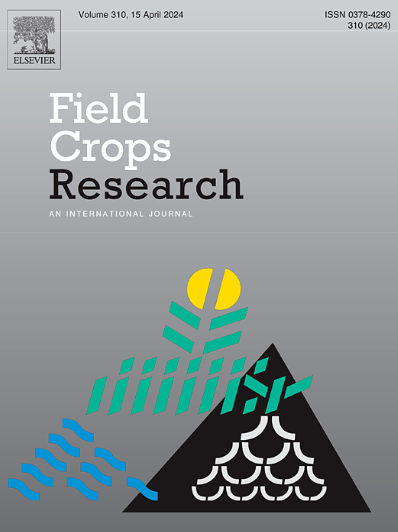在盐胁迫下,灌浆过程中淀粉和蛋白质积累不平衡导致籽粒蛋白质成分增加
IF 6.4
1区 农林科学
Q1 AGRONOMY
引用次数: 0
摘要
土壤盐渍化已成为水稻籽粒中蛋白质和淀粉代谢紊乱的限制因素。然而,盐胁迫介导的这些成分的合成和积累的调控机制仍然知之甚少。方法以4个水稻基因型(优香红道、天稻红2号、随香河诺、太黑香9号)为材料,进行为期2年的大田试验,分别进行淡水灌溉(CK)和海水与淡水混合(3.9 dS m−1 (T1)和7.5 dS m−1 (T2)) 3种盐水灌溉处理。测定了氮代谢相关酶、氮吸收、库容量、籽粒灌浆特性、蛋白质和淀粉及其组分等关键参数。结果盐胁迫显著提高了蛋白质成分含量,T1和T2处理显著提高了白蛋白含量(41.26 ~ 44.67 %;77.82-81.93 %),球蛋白(42.42-45.03 %;54.69 ~ 58.61 %),蛋白(26.27 ~ 28.54 %;58.17-58.28 %),谷蛋白(31.45-33.99 %;42.35-44.36 %)。这种增强是由两种协同机制造成的:1)直接促进蛋白质成分积累;2)由于粒重和淀粉积累的变化而产生的间接浓度效应。盐胁迫增加了籽粒氮供应(GNS),因为库容量的减少超过了花后穗氮积累(PNAP)。同时,通过降低叶面积指数(LAI)、叶绿素含量(SPAD表示)、籽粒灌浆速率和缩短籽粒灌浆时间,抑制淀粉积累,导致小粒粒重和蛋白质成分浓度降低。结论盐度对水稻籽粒蛋白质成分含量的影响主要来自于籽粒中蛋白质积累和浓度效应的增强,通过改变籽粒灌浆过程中的氮分配和抑制淀粉生物合成来介导。本文章由计算机程序翻译,如有差异,请以英文原文为准。
Imbalanced starch and protein accumulation during grain filling under salt stress leads to increased protein components in rice grains
Context
Soil salinization has emerged as a limiting factor that perturbs the metabolism of protein and starch in rice grains. However, the regulatory mechanism underlying salt stress-mediated synthesis and accumulation of these components remain poorly understood.
Method
A two-year field experiment was conducted using four rice genotypes (Youxianghongdao, Tiandaohong2, Suixiangheinuo, Taiheixiang9) subjected to three saline irrigation treatments: fresh water irrigation (CK) and mixtures of seawater and freshwater i.e., 3.9 dS m−1 (T1) and 7.5 dS m−1 (T2). Key parameters, including nitrogen metabolism related enzymes, nitrogen uptake, sink capacity, grain filling characteristics, protein and starch and its components were measured.
Results
Salt stress significantly enhanced protein component contents, with T1 and T2 treatments increasing albumin (41.26–44.67 %; 77.82–81.93 %), globulin (42.42–45.03 %; 54.69–58.61 %), prolamin (26.27–28.54 %; 58.17–58.28 %), and glutelin (31.45–33.99 %; 42.35–44.36 %) compared to CK. This enhancement resulted from two synergistic mechanisms: 1) direct promotion of protein components accumulation, and 2) indirect concentration effects due to the changes of grain weight and starch accumulation. Salt stress increased grain nitrogen supply (GNS) as the decrease of sink capacity exceeded that of post-anthesis nitrogen accumulation in panicle (PNAP). Concurrently, starch accumulation was inhibited through reduced leaf area index (LAI), chlorophyll content (as indicated by SPAD), grain filling rate and shortened grain-filling duration, resulting in a decrease in grain weight and concentration of protein components in smaller-sized grains.
Conclusions
The salinity-induced increase of protein components content in rice grain arises from both enhanced protein accumulation and concentration effects in smaller-size grains, mediated through altered nitrogen partitioning and suppressed starch biosynthesis during grain filling.
求助全文
通过发布文献求助,成功后即可免费获取论文全文。
去求助
来源期刊

Field Crops Research
农林科学-农艺学
CiteScore
9.60
自引率
12.10%
发文量
307
审稿时长
46 days
期刊介绍:
Field Crops Research is an international journal publishing scientific articles on:
√ experimental and modelling research at field, farm and landscape levels
on temperate and tropical crops and cropping systems,
with a focus on crop ecology and physiology, agronomy, and plant genetics and breeding.
 求助内容:
求助内容: 应助结果提醒方式:
应助结果提醒方式:


